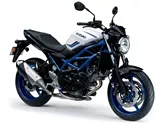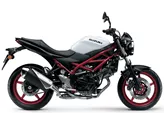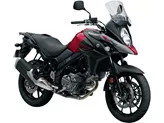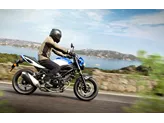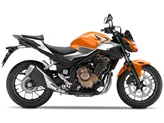Kawasaki ER-6n 2011 vs. Suzuki SV 650 2016

Kawasaki ER-6n 2011

Suzuki SV 650 2016
Vue d’ensemble - Kawasaki ER-6n 2011 vs Suzuki SV 650 2016
The Kawasaki ER-6n model year 2011 and the Suzuki SV 650 model year 2016 are both naked bikes with similar technical specifications. Both bikes have a 2-cylinder engine with liquid cooling and a displacement of around 650cc. They also have a monoshock rear suspension and a steel frame. The front brakes on both bikes are double disk with double piston calipers. The front and rear tire widths are also the same at 120mm and 160mm respectively.
In terms of engine power, the Suzuki SV 650 2016 has a slight advantage with 76 HP compared to the Kawasaki ER-6n 2011's 72 HP. However, the torque output is slightly higher on the Kawasaki ER-6n with 66 Nm compared to the Suzuki SV 650's 64 Nm. Both bikes have a comfortable seating position, with the Kawasaki ER-6n having a seat height of 790mm and the Suzuki SV 650 having a slightly lower seat height of 785mm.

Kawasaki ER-6n 2011
One of the strengths of the Kawasaki ER-6n 2011 is its ABS system, which provides added safety during braking. It also has wider handlebars and a slimmer waist, making it easier to maneuver in tight spaces. The increased intake noise adds to the overall riding experience. The seat on the Kawasaki ER-6n is comfortable, allowing for longer rides without discomfort. The chassis of the bike is uncomplicated, making it easy to maintain and repair.
On the other hand, the Suzuki SV 650 2016 has its own set of strengths. It has an agile and powerful engine, with a typical V2 sound that adds to the overall riding experience. The seating position is low and pleasant, making it comfortable for riders of different heights. The bike also has easy handling, allowing for effortless maneuvering in various riding conditions. The chassis of the Suzuki SV 650 is also comfortable, providing a smooth and stable ride. The brakes on the bike have good control, allowing for precise stopping power.

Suzuki SV 650 2016
One weakness of the Suzuki SV 650 2016 is the poorly readable digital tachometer. This may make it difficult for riders to accurately monitor their engine RPMs while riding.
In summary, both the Kawasaki ER-6n 2011 and the Suzuki SV 650 2016 are solid naked bikes with similar technical specifications. While the Suzuki SV 650 has a slightly more powerful engine, the Kawasaki ER-6n offers the advantage of ABS and a more comfortable seat. Ultimately, the choice between the two would depend on the individual rider's preferences and priorities.
Caractéristiques techniques Kawasaki ER-6n 2011 par rapport à Suzuki SV 650 2016
Avantages et inconvénients en comparaison
Avantages et inconvénients en comparaison
Kawasaki ER-6n 2011

Un ensemble aussi cohérent avec des détails aussi fins n'existe nulle part ailleurs à ce prix. L'ER-6n a retrouvé un peu de piquant sur le plan visuel et dynamique et est plus amusante que jamais.
Suzuki SV 650 2016

La nouvelle SV650 s'inscrit dans la lignée du minimalisme visuel des deux premières générations de SV650, tout en se basant techniquement sur son prédécesseur direct, la SFV650 Gladius - deux excellents coups qui font de la très moderne SV650 un classique. Le design s'inscrit parfaitement dans l'époque des nombreuses transformations rétro, mais à l'intérieur sommeillent aussi des gadgets modernes qui facilitent l'apprentissage, surtout pour les débutants. Le moteur, quant à lui, peut également convaincre les pilotes confirmés, le vrombissement typique du V2 est magnifique. En ce qui concerne le châssis et les freins, il ne faut pas s'attendre à une sportivité extrême, mais le prix de près de 6400 euros (en Allemagne) est une annonce qui fera sans doute avaler la poussière à la concurrence.
Comparaison des prix Prix moyen du marché Kawasaki ER-6n vs Suzuki SV 650
There are a few key differences between a Kawasaki ER-6n 2011 and a Suzuki SV 650 2016. In terms of price, the actual average price of a Suzuki SV 650 2016 is about 41% higher. A Kawasaki ER-6n 2011 experiences a loss of 230 USD in one year and 500 USD in two years of ownership. This is offset by a loss of 140 USD and 140 USD for a Suzuki SV 650 2016. Compared to Suzuki SV 650 2016 there are less Kawasaki ER-6n 2011 bikes available on the 1000PS.de Marketplace, specifically 5 compared to 11. It takes less time to sell a Kawasaki ER-6n with 49 days compared to 80 days for a Suzuki SV 650. Since model year 2006 1000PS.de editors have written 16 reviews for the Kawasaki ER-6n and 25 reviews for the Suzuki SV 650 since model year 2005. The first review for the Kawasaki ER-6n was published on 6/29/2005 and now has more than 11,200 views. This compares to more than 14,200 views for the first review on Suzuki SV 650 published on 9/26/2008.










